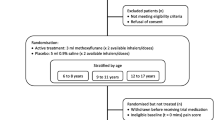Abstract
Methoxyflurane (Penthrox®) administered as an inhalation vapour via a hand-held inhaler is approved in Europe for the emergency relief of moderate to severe pain in conscious adults with trauma-associated pain. The time to the onset of meaningful pain relief is 3–4 min. Methoxyflurane provided effective levels of analgesia in patients presenting to the emergency department pain associated with minor trauma, was more effective than intramuscular tramadol when administered by paramedics for acute musculoskeletal pain, and had a more rapid onset of action than tramadol in patients presenting to the emergency department with ankle injuries. When used to relieve trauma pain in the emergency setting, methoxyflurane is generally well tolerated and, unlike when it was used at higher doses as an inhalational anaesthetic, is not associated with a risk of nephrotoxicity. With its non-invasive route of administration, ease of use and/or rapid onset of action, patient-administered inhaled methoxyflurane is a useful option for the management of trauma pain in the pre-hospital or emergency department setting.
Similar content being viewed by others
References
Downey LV, Zun LS. Pain management in the emergency department and its relationship to patient satisfaction. J Emerg Trauma Shock. 2010;3(4):326–30.
Alonso-Serra HM, Wesley K. Prehospital pain management. Prehosp Emerg Care. 2003;7(4):482–8.
Tainter CR. An evidence-based approach to traumatic pain management in the emergency department. Emerg Med Pract. 2012;14(8):1–26.
Stephen CR. Clinical applications of methoxyflurane. Acta Anaesthesiol Scand Suppl. 1966;24:215–22.
Mazze RI. Methoxyflurane revisited: tale of an anesthetic from cradle to grave. Anesthesiology. 2006;105(4):843–6.
Penthrox® (methoxyflurane) inhalation: Australian product information (version 13). Springvale (VC), Australia: Medical Developments International Pty. Ltd.; 2016.
Elliott JR, Elliott AA, Harper AA, et al. Effects of general anaesthetics on neuronal sodium and potassium channels. Gen Pharmacol. 1992;23(6):1005–11.
Krasowski MD, Harrison NL. The actions of ether, alcohol and alkane general anaesthetics on GABAA and glycine receptors and the effects of TM2 and TM3 mutations. Br J Pharmacol. 2000;129(4):731–43.
Penthrox 3 mL inhalation vapour, liquid: UK summary of product characteristics. Craigavon, Northern Ireland: Galen Ltd.; 2017.
Coffey F, Wright J, Hartshorn S, et al. STOP!: a randomised, double-blind, placebo-controlled study of the efficacy and safety of methoxyflurane for the treatment of acute pain. Emerg Med J. 2014;31(8):613–8.
Coffey F, Dissmann P, Mirza K, et al. Methoxyflurane analgesia in adult patients in the emergency department: a subgroup analysis of a randomized, double-blind, placebo-controlled study (STOP!). Adv Ther. 2016;33(11):2012–31.
Lim KJH, Koh ZX, Zafirah NA, et al. Clinical evaluation of Penthrox® (methoxyflurane) and tramadol for the Singapore emergency ambulance service [abstract plus oral presentation]. In: Society for Emergency Medicine in Singapore Annual Scientific Meeting International Resuscitation Science Symposium. 2016.
Konkayev AK, Baymagambetov S, Sainov M. Evaluation of clinical effectiveness of inhalatory analgesic «Penthrox» for pain relief in ankle injuries. Arch Balk Med Union. 2013;48(Suppl 3):239–43.
Nguyen NQ, Burgess J, Debreceni TL, et al. Psychomotor and cognitive effects of 15-minute inhalation of methoxyflurane in healthy volunteers: implication for post-colonoscopy care. Endosc Int Open. 2016;4(11):E1171–7.
Jacobs IG. Health effects of patients given methoxyflurane in the pre-hospital setting: a data linkage study. TOEMJ. 2010;3:7–13.
Middleton PM, Simpson PM, Sinclair G, et al. Effectiveness of morphine, fentanyl, and methoxyflurane in the prehospital setting. Prehosp Emerg Care. 2010;14(4):439–47.
Tveita T, Thoner J, Klepstad P, et al. A controlled comparison between single doses of intravenous and intramuscular morphine with respect to analgesic effects and patient safety. Acta Anaesthesiol Scand. 2008;52(7):920–5.
Mercadante S, Radbruch L, Davies A, et al. A comparison of intranasal fentanyl spray with oral transmucosal fentanyl citrate for the treatment of breakthrough cancer pain: an open-label, randomised, crossover trial. Curr Med Res Opin. 2009;25(11):2805–15.
Penthrox: assessment of potential for abuse & dependency [report no. 137618005-001-R-Rev0; conducted for Medical Developments International]. Richmond (VIC), Australia: Golder Associates PTY Ltd; 2013.
Dayan AD. Analgesic use of inhaled methoxyflurane: evaluation of its potential nephrotoxicity. Hum Exp Toxicol. 2016;35(1):91–100.
Komesaroff D. Pre-hospital pain relief: Penthrane or Entonox? Aust J Emerg Med. 1995;2:28–9.
Griffiths E. Efficacy and safety of methoxyflurane: managing trauma associated pain in UK SAR helicopter paramedic practice. J Paramedic Practice. 2017;9(3):108–20.
Blair HA, Frampton JE. Methoxyflurane: a review in trauma pain. Clin Drug Investig. 2016;36(12):1067–73.
Acknowledgements
The manuscript was updated from Clinical Drug Investigation 2016;36(12):1067–73 [23], and was reviewed by: A.D. Dayan, London, UK; E. Griffiths, UK Search and Rescue, North Wales, UK; S. Hartshorn, Emergency Department, Birmingham Children’s Hospital, Birmingham, UK; A. Konkayev, Astana Medical University, Astana, Kazakhstan; J. Mclennan, Emergency Medicine, Royal Stoke University Hospital, Stoke on Trent, UK. During the peer review process, the marketing authorization holder of methoxyflurane was also offered an opportunity to review this article. Changes resulting from comments received were made on the basis of scientific and editorial merit.
Author information
Authors and Affiliations
Corresponding author
Ethics declarations
Funding
The preparation of this review was not supported by any external funding.
Conflicts of interest
H. A. Blair and J. E. Frampton are employees of Adis/Springer, are responsible for the article content and declare no conflicts of interest.
Additional information about this Adis Drug Review can be found at http://www.medengine.com/Redeem/60E8F0603564A77D.
Rights and permissions
About this article
Cite this article
Blair, H.A., Frampton, J.E. Methoxyflurane inhalation vapour in trauma pain: a profile of its use in the EU. Drugs Ther Perspect 33, 403–408 (2017). https://doi.org/10.1007/s40267-017-0433-7
Published:
Issue Date:
DOI: https://doi.org/10.1007/s40267-017-0433-7



